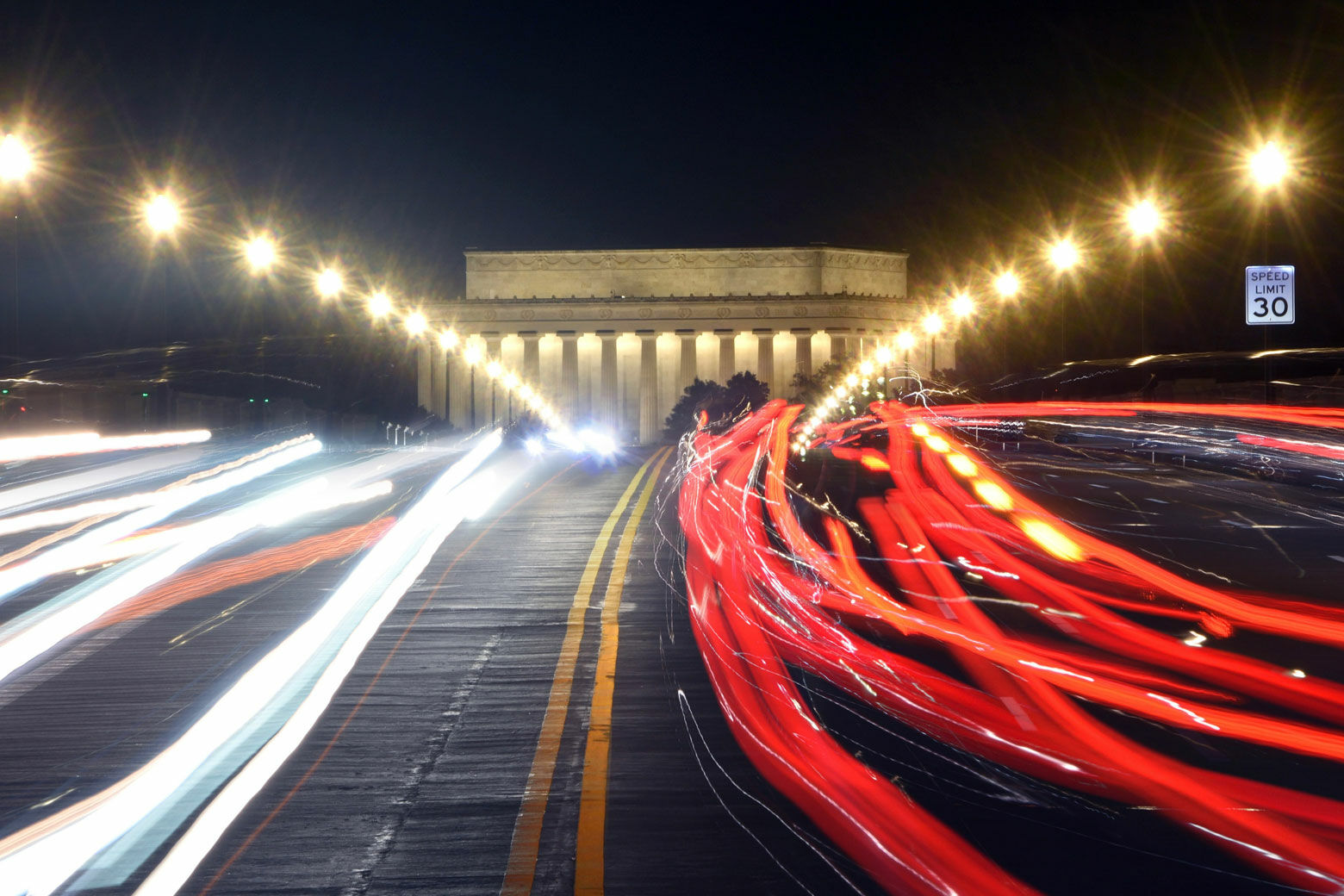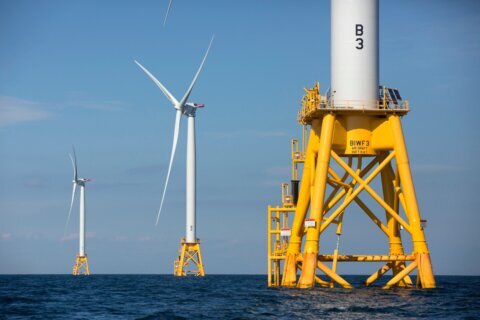
Editor’s note: Making fun of D.C. traffic is nothing new, but as a veteran traffic reporter, WTOP’s Dave Dildine can do it like few others. Remember, everything written here comes from a place of love (and maybe just a smidge from a place of absolute fury). Read his first guide.
“I remember a time of chaos, ruined dreams, this wasted land. But most of all, I remember the road warrior … On the roads it was a white-line nightmare …”
— Narrator, Mad Max 2: The Road Warrior (1981)
All drivers eventually face a day of reckoning — a testing time when their abilities, the degree of their success or failure as a motorist, will be revealed in triumphant or cataclysmic fashion.
From whirling through white-knuckle traffic circles to dodging high-speed stunt drivers to coping with crippling congestion, the tests in the D.C. region aren’t for the faint of heart.
Traffic circles
Before steering into a D.C. traffic circle, it is best to review your estate plan and beneficiary designations. Pinning insurance information to your person is considered a common courtesy.
Expect local drivers to enter all traffic circles with reckless abandon, without a hint of yielding, while asserting immediate and unrelenting right of way. This centrifugation of traffic usually occurs just below a velocity that would result in instantaneous rollovers.
The only way to exit most D.C. traffic circles is by accelerating around the innermost lane rapidly enough to receive an orbital assist.
In other words, the nerve-racking nature of the District’s traffic circles has very little to do with who actually has the right of way but rather the implied law that no driver shall, for any conceivable reason, yield or slow down at any time.
Washington’s street grid is festooned with about three dozen traffic centrifuges, thanks to the Federal City’s original planner, Pierre Charles L’Enfant. Although the automobile had not yet been invented, L’Enfant was a visionary and, in 1791, he set forth to design a road network that would punish and torment future travelers for centuries to come.
Listed below are some tips for navigating some of Washington’s most notorious traffic circles.
Dupont Circle: For the largest circle in the city, a degree in advanced physics is required before entering. It is not uncommon for unprepared drivers to be trapped between the spokes in the outer circle for days on end. Remain on defense. Pack a meal, change of clothes and a first aid kit.
Westmoreland Circle (at the Maryland-District line along Massachusetts Avenue): Given the irregular striping and lane tapering, you will have a one-in-three chance of colliding with another motorist or a fixed object, such as a tree (which definitely ran out in front of you) before extraction.
Do not attempt to exit the circle on any specific alignment; veer off the circle as quickly as possible and be grateful if you end up on any road at all.
Ward Circle (near American University): A bunch of new traffic control devices, including electronic signs, bollards and curbs are meant to rein in erratic behavior, but self-entitled drivers continue to make illegal left turns from the circle’s center cut-through, usually at a right angle to oncoming traffic. (Helpful hint: If you’re moving at any angle in a circle, you’re probably doing something wrong.)
A small group of college students has been trapped inside Ward Circle for more than five months. The marooned undergrads are the first people ever to penetrate the murderous traffic flow to reach the General Artemas Ward statue, but have since subsisted off of storm water runoff and grubs.
Urban search and rescue crews have, so far, been unable to reach them.
Memorial Circle (at the western end of Arlington Memorial Bridge): Invert everything you think you know about who has the right of way in traffic circles. Outbound drivers on Memorial Bridge have the right of way, and drivers in the circle are supposed to yield.
For visitors heading back to Reagan National Airport after a week of practicing, this final traffic circle test usually ends in complete failure and embarrassment.
Washington Circle (downtown near George Washington University Hospital): From K Street, drivers should decide whether to sacrifice half a day in the circle itself, or tempt fate with the city’s most lucrative and unscrupulously positioned speed enforcement camera in the bypass below the circle.
Many locals and transplants frequently lament the traffic conditions that result from what they like to call Dave Thomas Circle, at New York and Florida avenues in Northeast. Except Dave Thomas Circle isn’t a circle; it isn’t the intersection’s name; the Wendy’s is being demolished and the moniker is a less-than-flattering dedication to late fast-food tycoon.
Still, the misnomer “Dave Thomas Circle” refuses to go away, much like the superfluous media inventions “Mixingbowl” and “Top Side” that attempt to describe random portions of the Capital Beltway.
Similar waggish nicknames for these roads include the “NoMa Noodle,” “Topsy Turvy Top Side Belt-Buckler” and “Springfield Soul-Crusher.”
Shifting into high gear
Times are changing. Gentrification is moving rapidly throughout the District, and so are the dump trucks that are hurtling through its newest developer-inspired neighborhoods.
Occasionally, pedestrians will catch a glimpse of a dump truck (usually with a raised bed) breaking the sound barrier. Some will marvel in awe; others will cower in fear as a deafening roar trails behind the solid steel behemoths.
The speed of drivers sporting diplomat plates ranges from 60 mph below the limit to 60 mph above. The slowest of these vehicles, defying the laws of physics, move at such an infinitesimally slow rate, it is hypothesized that they bottleneck traffic in parallel dimensions.
About 10 years ago, the D.C. area’s suffocating congestion was spiced up when the ride-share revolution came to town. Now, instead of boring, old-fashioned gridlock, the roads are effectively kept at capacity by a legion of perpetually circling, idling, spasmodic drivers for hire.
Ride-share drivers plod along at a nominal pace but, when you least expect it, will abruptly halt traffic to drop off passengers in the middle of the road, even with vacant curb lanes nearby.
The potential of being sideswiped or rear-ended is highest as the driver and passenger exchange pleasantries and share an extended goodbye through the side window. The resulting backup will often be accompanied by a symphony of honking set in D minor.
Long before the recent ride-share revolution, a secret society of coy commuters dwelled in the underbelly of the D.C. transportation network for decades. Look carefully in the dark recesses of the traffic-choked streets and you might just catch a glimpse into the secret lives of slugs.
These crepuscular creatures have a complex social structure. Their colonies undertake daily migrations, known as sluglines, that span great distances. Very little is known about this secretive species.
Occasionally, convoys of narcissistic hooners in gaudy sports cars, dirt bikes and ATVs will indulge their inferiority complexes and spontaneously perform figure-eights, burnouts and other stunts on public roads and sidewalks.
While it might be part of a bizarre mating ritual, these self-aggrandizing performances are usually staged for some clicks on a trifling social media account. Those forced to bear witness to these events should avert their gaze from the vehicles in question, lest they catch a glimpse of some terrible Instagram handle stickered to a rear window panel.
Remember, left turns are not allowed in the District. On some streets, right turns are also not allowed. Drivers on these streets are only allowed to go straight and should proceed poleward into Quebec where certain turn movements are permitted. Add an extra 14 hours of travel time.
Beyond the Beltway
Beyond the District line, downtown gridlock transitions into a syrupy suburban sluggishness. Here, car-centric commuters cling to the unsustainable 1950s tradition of commuting vast distances daily, as if the population hasn’t quadrupled in the decades since.
The magnitude of the traffic congestion on Interstate 95 near the Occoquan River, in Virginia, is so intense nowadays that it literally threw off the scale of a review of potential highway improvements from North Carolina to the Woodrow Wilson Bridge. (No, really; that actually happened.)
Some woebegone travelers have boldly attempted to navigate the I-95 mainline on Fridays and have never been heard from again. Their names and final destinations are etched in epitaphs at the Dale City Rest Area.
Scientists now theorize that a vertex of the Bermuda Triangle lies inland somewhere between the Lorton Workhouse and the Occoquan Historic District.
The region’s most daring commuters drive on the Beltway through Silver Spring, the most crash-prone stretch of I-495 in the region. When it rains, the “Topsy Turvy Top Side Belt-Buckler” transforms into the world famous “Silver Spring Spin-out Slip ‘n Slide.”
Nearby, in the shadow of the Mormon Temple, lies the sacred Seminary Road work site. Originally expected to be completed in 2018, the bridge rehabilitation project will continue eternally as a test of faith for drivers on the Beltway.
Drivers experiencing a drain on their sanity while passing through this area should take comfort in knowing that it is being used as an offering to a slumbering Ancient One, and may just buy humanity another year as the dominant life form on this planet.
(Note: The Silver Spring ZIP code spans about 450,000 square miles and extends from Nova Scotia to the Tennessee Valley. If someone tells you they’re from Silver Spring, they could actually live in Knoxville or Poughkeepsie.)
The Maryland Department of Transportation is also celebrating the continued construction along Route 210 near Kerby Hill Road, now in its 75th year. Like a never-ending super sale at a furniture outlet, the construction has been held over another five years with deep delays and red tag slowdowns.
Vocal factions of Marylanders have recently opposed the proposal to add high-occupancy toll lanes to the Beltway.
Unlike their snooty, Lexus-loving neighbors in Virginia, these groups (surely equipped with an impeccable understanding of how congestion pricing effects highway throughput and how travel demand forecast models work) prefer that their section of the Beltway and the American Legion Bridge remain exactly as they are; underfunded, congested and crumbling.
As is customary on Capitol Hill, when it comes to matters on the Capital Beltway, both sides feel that an inflamed and uncompromising approach is best.
The highways and parkways around the region are a little bumpy from years of deferred maintenance, but it’s nothing that your personal mine-resistant armored tank can’t handle.
From time to time, the media will report that a sinkhole has opened up on an area roadway. The word “sinkhole” is deliberately chosen to give the false impression that a giant, geologic pit thousands of feet deep and home to eldritch horrors has opened up, swallowing an untold number of motorists and perhaps rendering the road impassable for years on end.
Fear not. The sinkhole will turn out to be just some sediment scoured away from yet another water main break. That realization won’t stop everyone from talking about it as if it were a catastrophic surface collapse with a diameter equivalent to Falls Church.
The many trials and tribulations of D.C. drivers are augmented by the detours, distractions, deflections and diversions outlined above.
Complaining about the region’s traffic is a century-old tradition. It is also a form of self-loathing. After all, you don’t get stuck in D.C. traffic — you are D.C. traffic.








